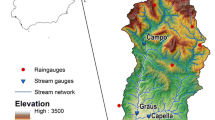Abstract
The present work was carried out in the framework of the Lesotho-Italy cooperation project “Renewable Energy Maps for Lesotho,” launched in 2016, with the main purpose to produce a series of maps aimed to support the Government of Lesotho in planning and expanding the exploitation of renewable energy sources (wind, solar and hydro). A multiple regression model specifically developed for sediment yield assessment in Lesotho catchments is here presented with a view to contributing to the follow-up of development projects in the field of hydroelectric energy. The “Lesotho model,” based on observations at 16 gauging stations, takes into account the proportions of agricultural and sedimentary bedrock areas as explanatory variables. Statistical reliability tests proved the model robustness after previous models, developed at continental or sub-continental scale, revealed to be ineffective or hardly applicable. A map of simulated sediment yields at sub-catchment level is provided, as an example of model application.


(data from FAO 2017)


(redrawn from Department of Mines and Geology 1982)









Similar content being viewed by others
References
Chakela QK (1981) Soil erosion and reservoir sedimentation in Lesotho. UNGI Rapport Nr 54, Scandinavian Institute of African Studies, Uppsala
Chakela QK (1992) Problems of monitoring erosion and sediment yields in Southern Africa. In: Erosion and sediment transport monitoring programmes in river basins, proceedings of the Oslo symposium, IAHS Publ. No. 210, pp 327–335
Del Sette P, Arduino G (1998) Ground water project. Lesotho 1983–1994. Italian Cooperation Project Report, Movimondo Molisv
Department of Mines and Geology, Lesotho Government (1982) Geological Map of Lesotho. Available at: https://esdac.jrc.ec.europa.eu/resource-type/. Accessed 20 December 2019
FAO—Food and Agriculture Organization of the United Nations (2017) Land cover Atlas of Lesotho. Rome, Italy, www.fao.org
Fournier F (1960) Climat et érosion; la relation entre l'érosion du sol par l'eau et les précipitations atmosphériques. Presses universitaires de France
Fournier F (1962) Map of erosion danger in Africa south of the Sahara. EEC, Commission for Technical Cooperation in Africa, Paris
Le Roux JJ (2018) Sediment yield potential in South Africa’s only large river network without a dam: implications for water resource management. Land Degrad Dev 29:765–775
Makhoalibe S (1984) Suspended transport measurement in Lesotho. In: Proceedings of IAHS symposium: challenges in African hydrology and water resources. Harare
Ministry of Water (2018) State of water resources report. Commission of water, 15 UN Road Sentinel Park Building L, Maseru, Lesotho
Nash JE, Sutcliffe JV (1970) River flow forecasting through conceptual models part I—a discussion of principles. J Hydrol 10(3):282–290. https://doi.org/10.1016/0022-1694(70)90255-6
Rooseboom A, Verster E, Zietsman HL, Lotriet HH (1992) The development of the new sediment yield map of southern Africa. WRC Report No. 297/2/92
Schmitz G, Rooyani F (1987) Lesotho geology, geomorphology, soils. The National University of Lesotho, Morija Printing Works, Morija, Lesotho
Strakhov NM (1967) Principles of lithogenesis, vol 1. Oliver and Boyd, Edinburgh
Strömquist L, Lundén B, Chakela Q (1985) Sediment sources, sediment transfer in a small Lesotho catchment—a pilot study of the spatial distribution of erosion features and their variation with time and climate. South Afr Geogr J 67:3–13
Tukey JW (1958) Bias and confidence in not quite large samples. Ann Math Stat 29(2):614. https://doi.org/10.1214/aoms/1177706647
Vanmaercke M, Poesen J, Broeckx J, Nyssen J (2014) Sediment yield in Africa. Earth Sci Rev 136:350–368. https://doi.org/10.1016/j.earscirev.2014.06.004
van Rooy JL, van Schalkwik A (1993) The geology of Lesotho highlands water project with special reference to the durability of construction materials. J Afr Earth Sci 16(1/2):181–192
Walling DE (1983) The sediment delivery problem. J Hydrol 65:209–237
Walling DE (1984) The sediment yield of African rivers. In: "Challenges in African hydrology and water resources" proceedings of the Harare symposium, IAHS Publ. No. 144, pp 265–283
Acknowledgements
The authors wish to thank the personnel from Lesotho Institutions (Department of Energy, Lesotho Meteorological Service, Lesotho Highlands Development Authority, Land Administration Authority, Department of Mines and Geology, Department of Water Affair, Bureau of Statistics) and from the Food and Agriculture Organization of the United Nations for providing data. Thanks to the anonymous reviewers for the suggestions that helped us to improve the paper.
Funding
This work was supported by the Italian Ministry for the Environment, Land and Sea (IMELS) in the framework of the “Memorandum of Understanding on cooperation in the field of climate change vulnerability, risk assessment, adaptation and mitigation,” signed in 2016 between IMELS and the Ministry of Energy and Meteorology of the Kingdom of Lesotho (Grant Number: I31I18001000001).
Author information
Authors and Affiliations
Contributions
SG contributed to conceptualization, SG, FP contributed to formal analysis and investigation, SG contributed to writing—original draft preparation, SG, FP contributed to writing—review and editing, CT contributed to material preparation and data collection.
Corresponding author
Ethics declarations
Conflict of interest
The authors declare that they have no conflict of interest.
Additional information
Publisher's Note
Springer Nature remains neutral with regard to jurisdictional claims in published maps and institutional affiliations.
Rights and permissions
About this article
Cite this article
Grauso, S., Pasanisi, F. & Tebano, C. Modeling the suspended sediment yield in Lesotho rivers. Model. Earth Syst. Environ. 6, 759–768 (2020). https://doi.org/10.1007/s40808-020-00738-5
Received:
Accepted:
Published:
Issue Date:
DOI: https://doi.org/10.1007/s40808-020-00738-5




